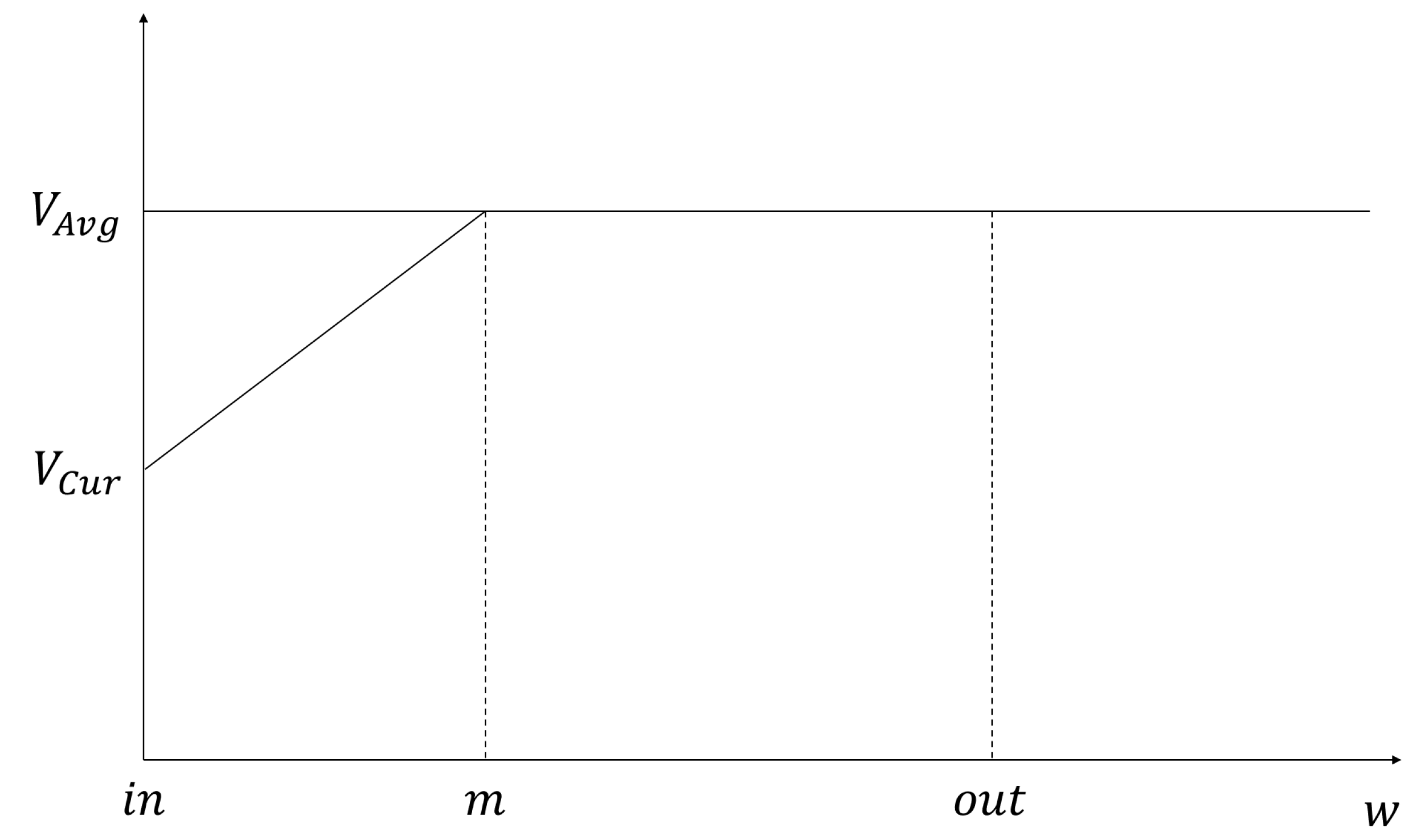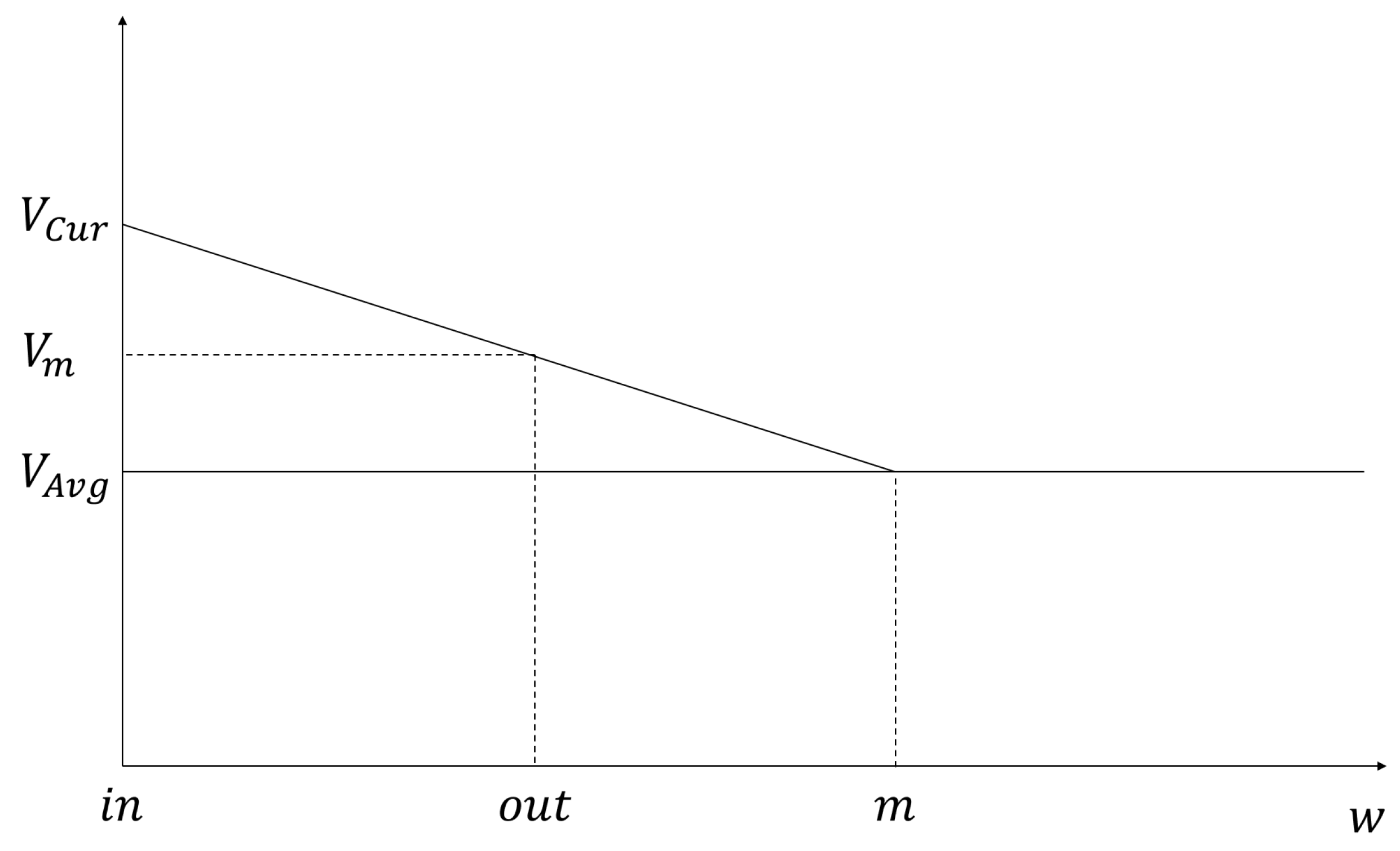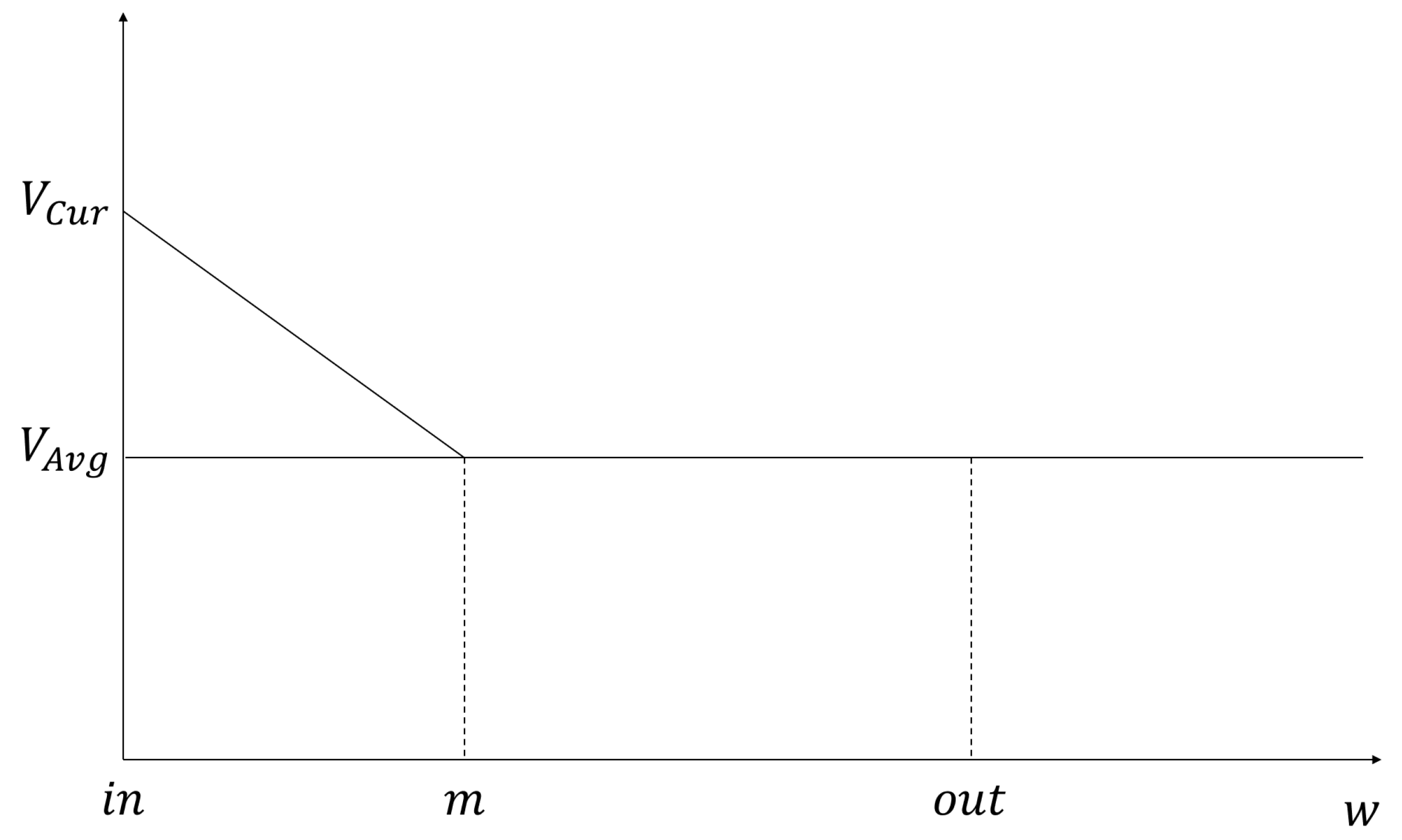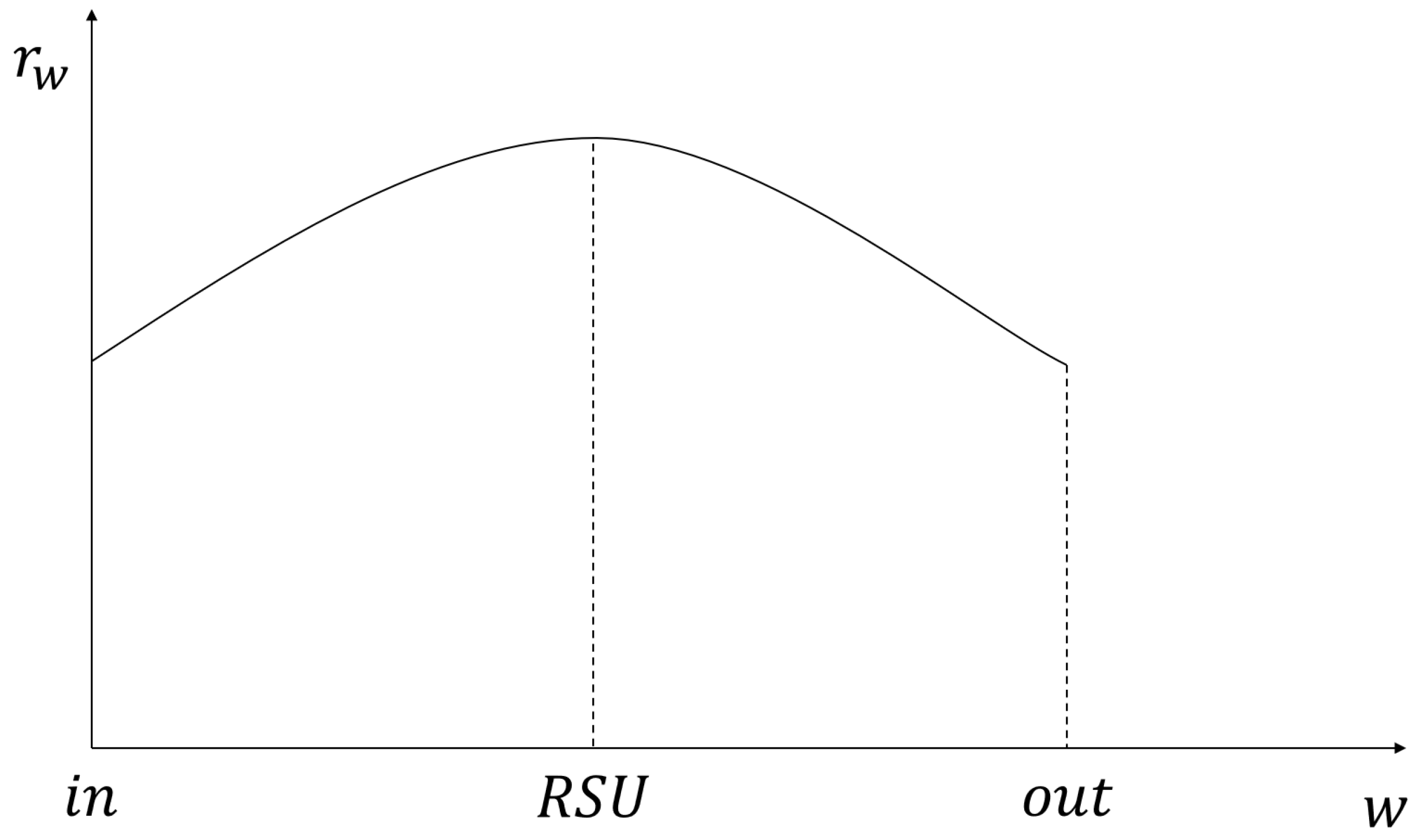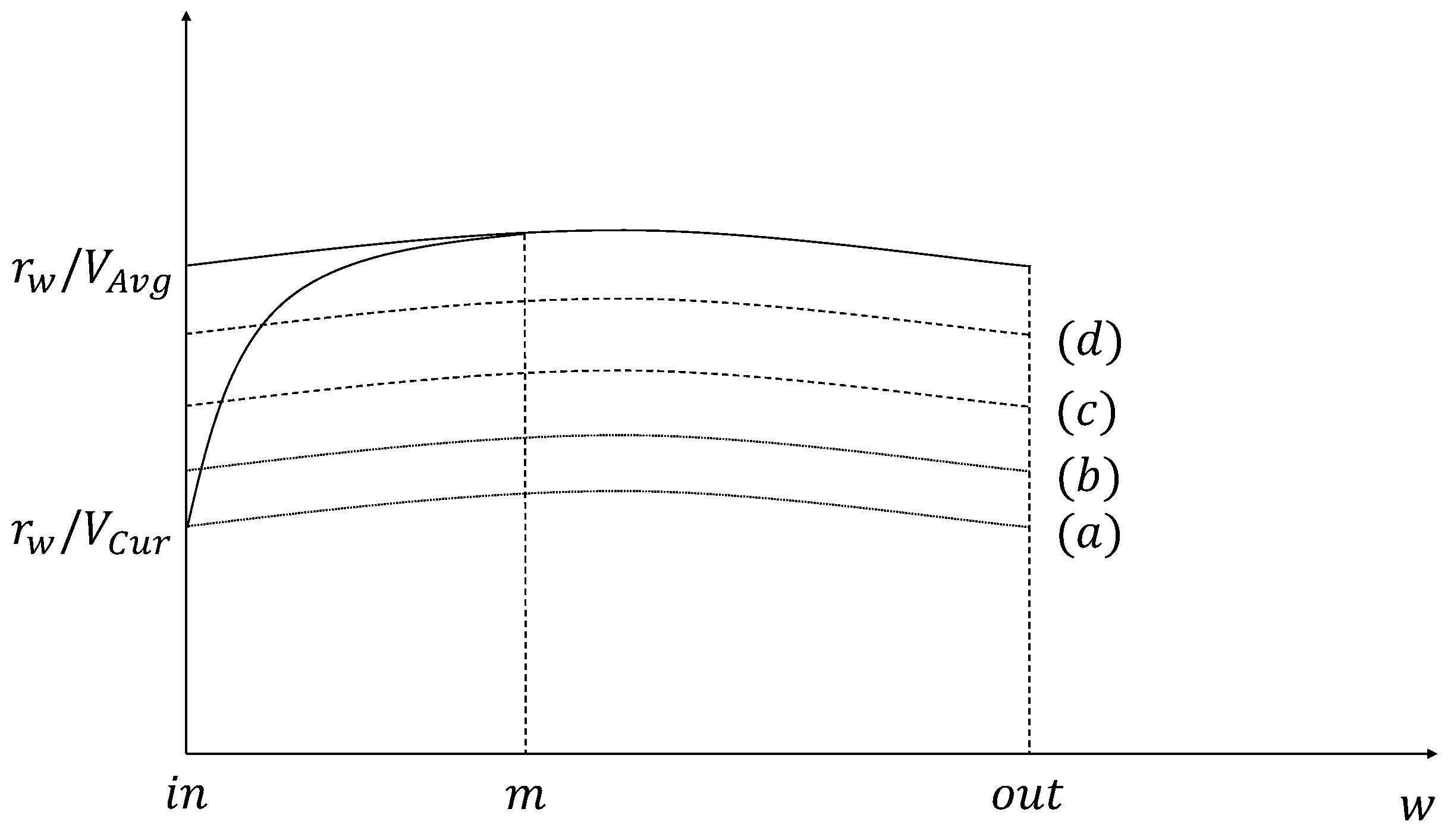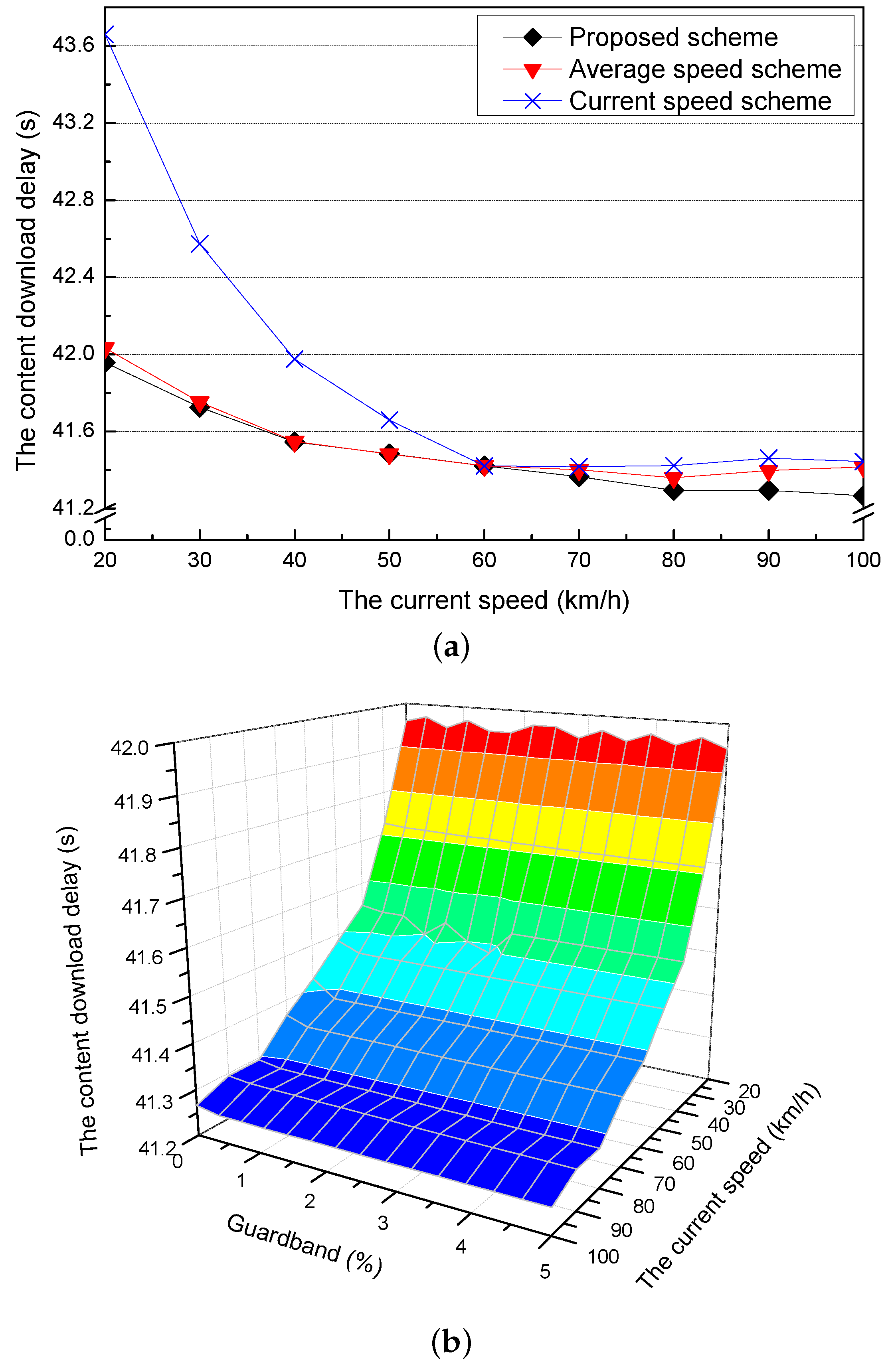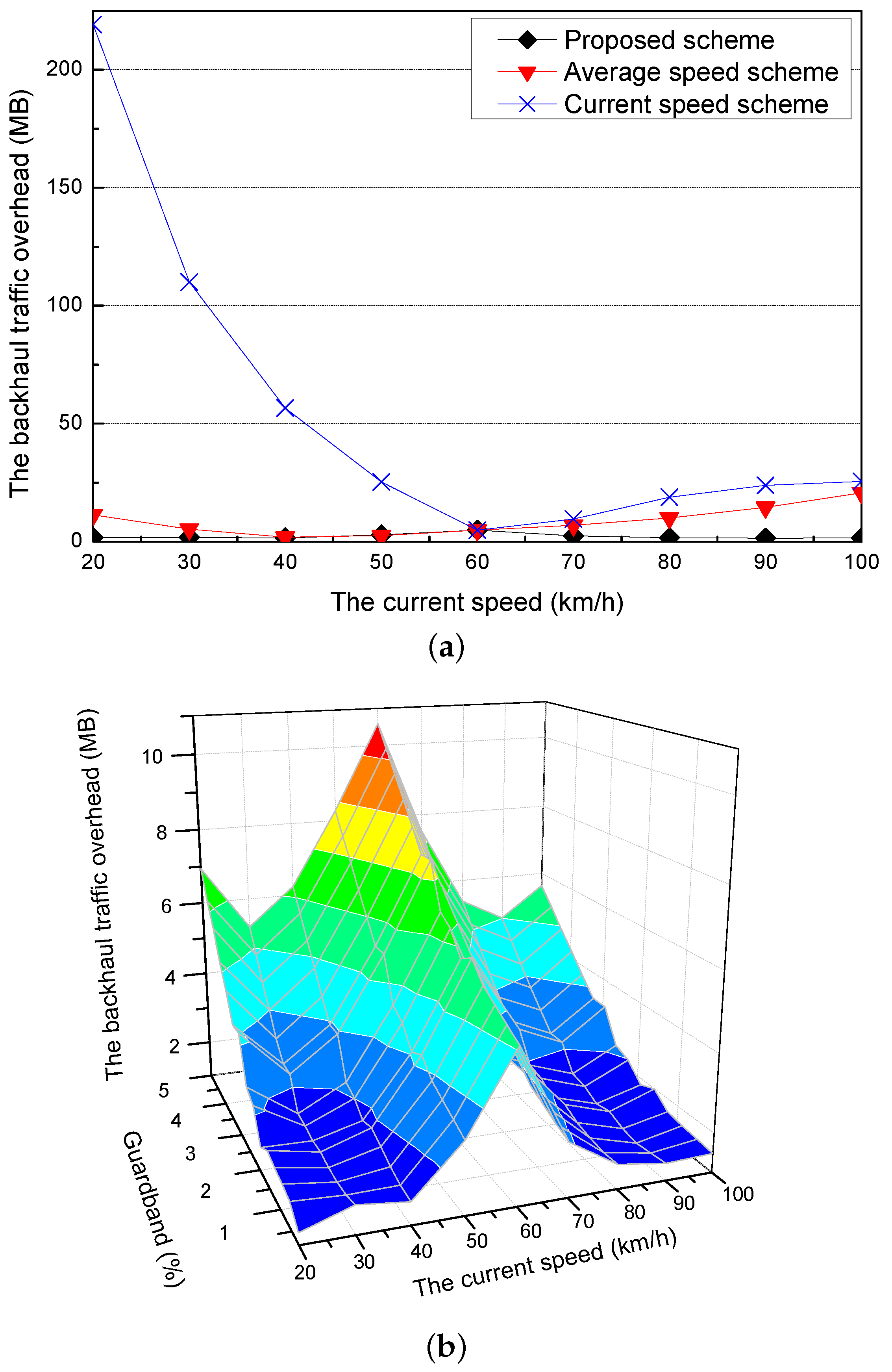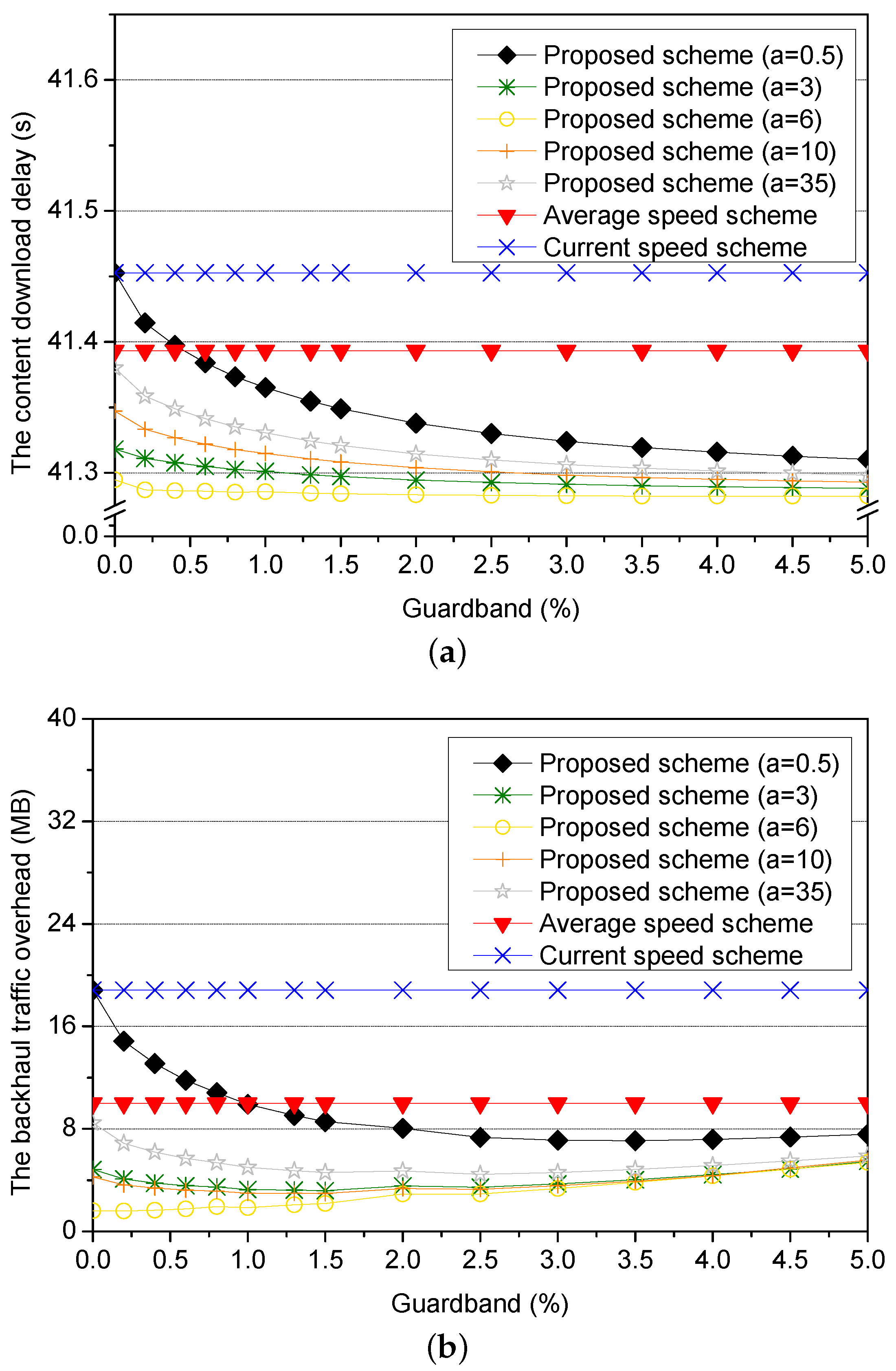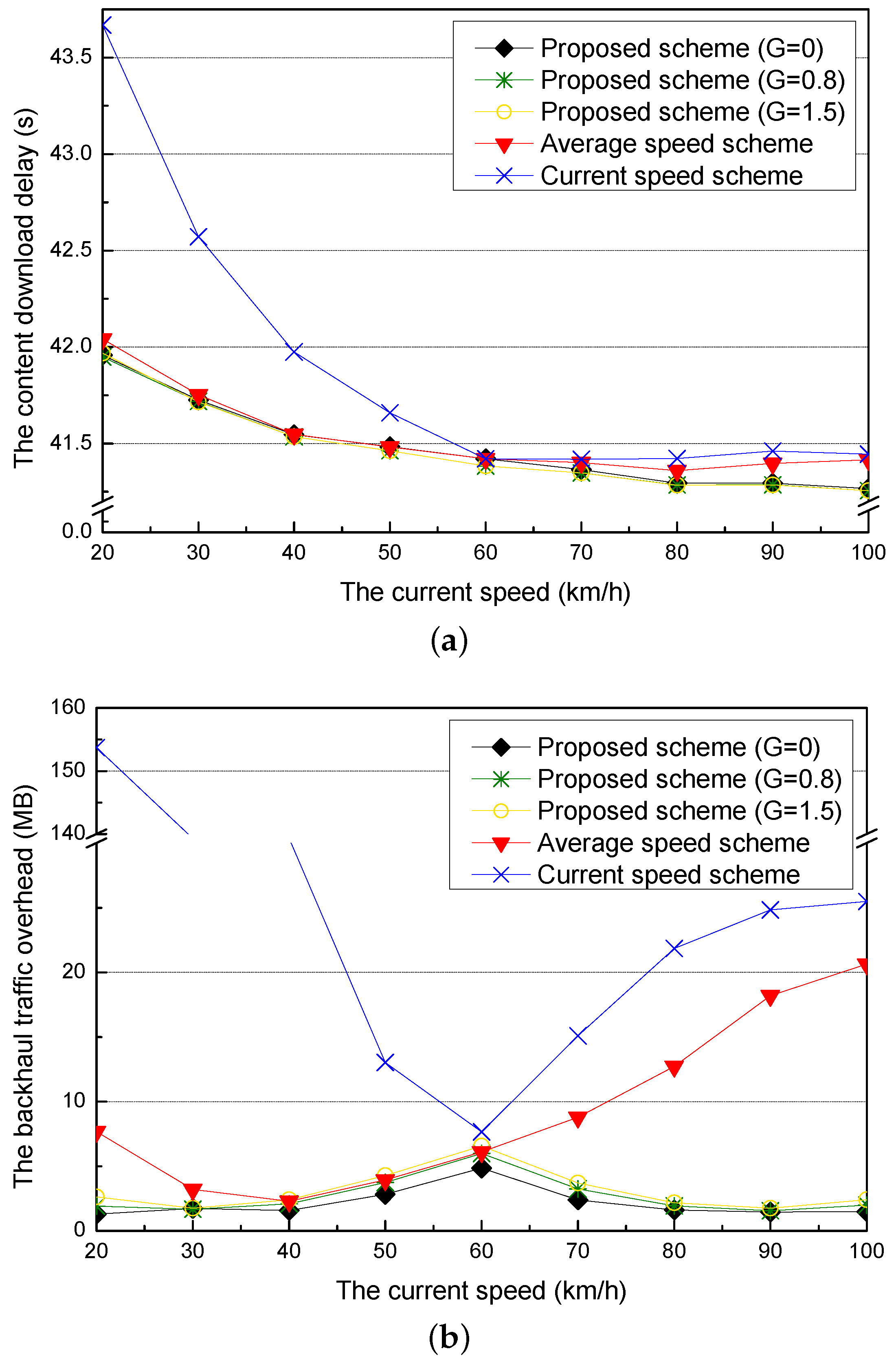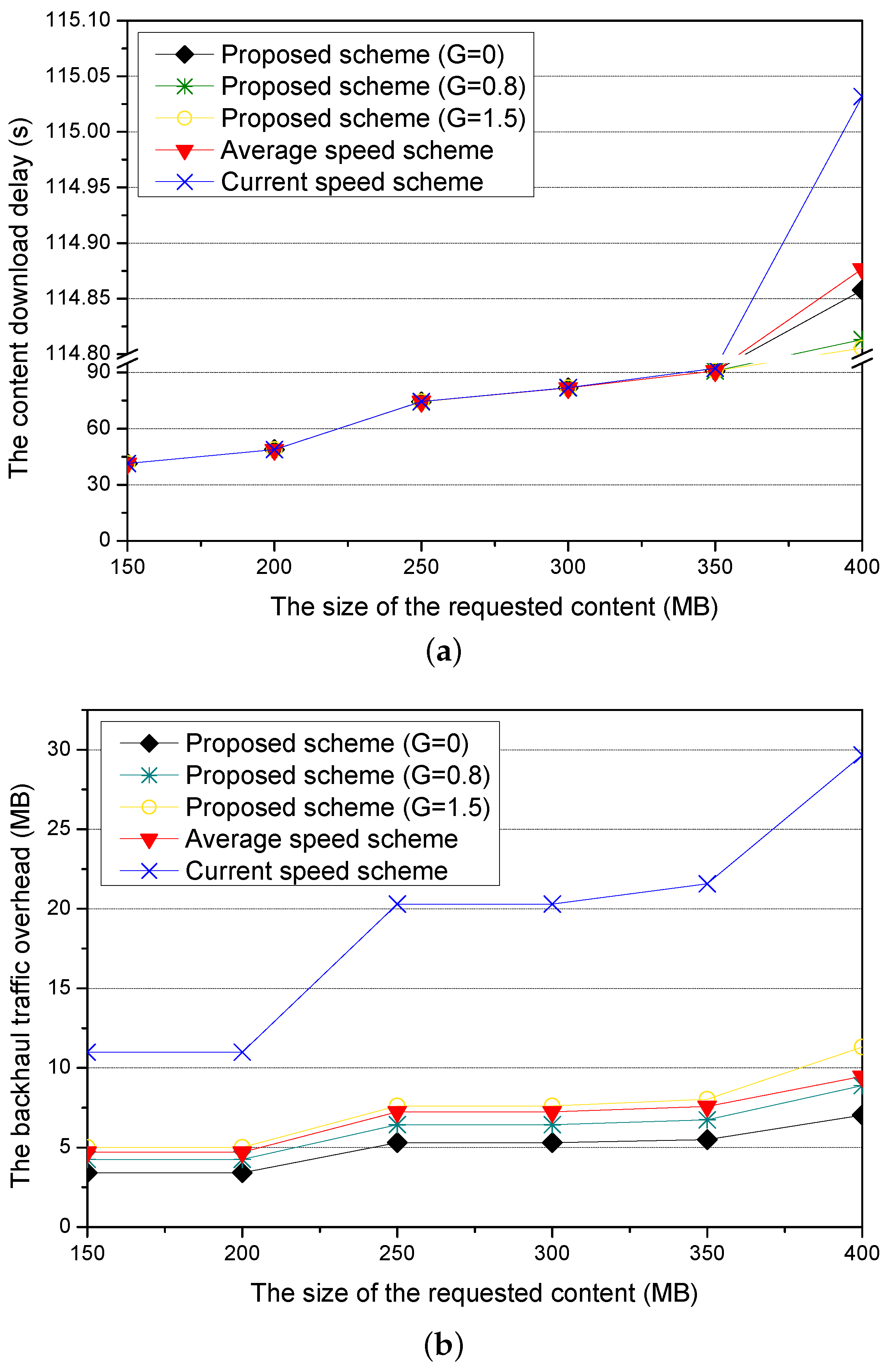1. Introduction
With the fast development in wireless communications and vehicular technologies, vehicular ad hoc networks (VANETs) have enabled us to deliver data to vehicles through wireless and mobile communication networks in vehicular environments [
1]. Many projects (e.g., VIC’S [
2], CarTALK 2000 [
3], NOW (Network-on-Wheels)) and industry groups (e.g., the Car2Car Communication Consortium [
4]) have conducted various research to provide the intelligent transport system by using VANETs. In the intelligent transport system, VANETs enable us to provide drivers and passengers with safety and convenience, and introduce new applications for entertainment and environment monitoring [
5]. Many studies on VANETs have addressed various applications such as car accident warning for active safety, emergency vehicle access for public service, road congestion notice for improved driving, and commercial advertisement for business [
6,
7]. However, the existing VANETs protocols are considered as an inefficient approach to share vehicular contents between vehicles because they rely on a host-centric communication paradigm based on IDs.
The paradigm of Content-Centric Networking (CCN) has been proposed to provide a general communication form to achieve efficient content distribution and sharing on the Internet. CCN focuses on what (content) instead of where (host) [
8]. In CCN, a content requester that is interested in an intended content broadcasts an interest packet for searching the content. Content publishers or providers having the content and receiving the Interest packet send out the content to the content requester via the reverse path of the interest packet. Then, nodes on the path of the content delivery cache the content in their own storage to instantly respond to interest packets from other content requesters [
9]. Recently, a Content-Centric Vehicular Networking (CCVN) framework has been introduced to apply CCN in vehicular networks with RoadSide Units (RSUs) [
10]. Instead of broadcasting an interest packet to search an intended content, the CCVN framework allows a requester vehicle to send the interest packet only to the RSU where it is located. The RSU delivers the interest packet to a content provider (i.e., a content server or a content publisher) of the content through its backhaul links, receives the content from the content server and downloads the content to the requester vehicle. Then, CCVNs also allow the RSU to cache the content to immediately respond to interest packets from other requester vehicles and thus enhance the performance of content downloading. Many studies on caching have been researched about where, what, and how long to cache contents on RSUs receiving them in CCVNs [
11,
12,
13,
14,
15].
Owing to the development of various vehicular applications, both the number of contents and the number of requester vehicles increase rapidly [
16]. Accordingly, a great number of demands for searching contents happens from a lot of vehicles in CCVNs. To efficiently handle the high demands, the research on proactive caching (i.e., precaching) have been actively conducted in CCVNs [
17,
18,
19,
20,
21,
22,
23,
24]. Precaching proactively caches anticipated contents for vehicles at RSUs from content servers in advance even though they have never been requested by vehicles. Many studies on precaching determine contents or RSUs for precaching by considering factors such as the mobility of vehicles or the popularity of contents. Since precaching enables vehicles to immediately download precached contents from RSUs without using content servers, it reduces the delay of content downloading and the overhead of backhaul link traffic in CCVNs. However, due to the large size of contents such as multimedia content (for example, videos on YouTube, Netflix, etc.), a vehicle has the difficulty to download the whole amount of content within the coverage of the RSU where it is currently connected [
19]. As a result, when it enters the next RSU, it resends the interest packet to the next RSU. Thus, it should wait to download the content until the next RSU receives the content from the content provider. It increases the delay of content downloading.
To solve the problem of the content downloading delay for the large size of contents, the research on mobility-based precaching has been recently conducted by many studies in CCVNs [
17,
25,
26,
27]. The mobility-based precaching exploits precaching of contents in continuous next RSUs on the trajectory of the vehicle. In this precaching method, an intended content requested for a vehicle is proactively cached to the next RSU on its trajectory before it arrives at the next RSU. For content precaching, these schemes proactively cache the same copy of the whole content (i.e., full precaching) for the vehicle to the next RSU where it arrives after leaving the current RSU [
11]. However, since the full precaching caches the unnecessary parts (that the vehicle already downloaded in the current RSU or cannot download in the next RSU) of the content to the next RSU, it increases traffic of backhaul links and overheads of caching storages. To solve this problem of the full precaching, several schemes have been proposed to proactively cache only the downloadable amount (i.e., partial precaching) of the content for the vehicle in the next RSU [
28,
29,
30,
31]. In the partial precaching, the information of vehicle speeds is used to calculate the downloadable amount of the content. Then, these schemes use only the constant speed as the vehicle speed information which is the current speed [
28,
29,
31] of the requester vehicle or the average speed [
30] of vehicles in the next RSU. However, since the current speed and the average speed do not appropriately reflect the practical speed of the requester vehicle in the next RSU, the previous schemes could incorrectly calculate the downloadable amount of the content in the next RSU. If the downloadable amount of the content is calculated more than the amount that the vehicle can practically download in the next RSU, it increases the overhead of backhaul traffic [
32]. In contrast, if the downloadable amount of the content is calculated less than the amount that the vehicle can practically download, it increases the delay of content downloading.
Therefore, we propose an adaptive content precaching scheme (ACPS) that efficiently reduces the delay of content downloading and the overhead of backhaul traffic for the mobility-based partial precaching in CCVNs. First of all, ACPC estimates the predictive speed of a requester vehicle in the next RSU to accurately reflect its practical speed. The predictive speed of the requester vehicle is adjusted to the average speed of vehicles in the next RSU from starting with the current speed of the requester vehicle by the optimized adaptive value. Then, ACPS calculates the downloadable amount of the content for the requester vehicle in the next RSU from its predictive speed. Since the predictive and the practical speeds of the requester vehicle in the next RSU might have a subtle error between them, the hit ratio of precaching about the downloadable amount of the content is reduced and thus the content downloading delay raises. ACPS adds a guardband area to the downloadable amount to compensate for the subtle error of the speed prediction. Then, ACPS carries out precaching of the downloadable amount with the guardband area in the next RSU. As a result, the requester vehicle can immediately download the precached content from the next RSU when it arrives at the next RSU. Simulation results conducted in various environments verify that ACPS achieves better performance than a current speed scheme [
31] and an average speed scheme [
30] among the previous mobility-based partial precaching schemes in terms of the content downloading delay and the backhaul traffic overhead.
Our goal in this paper is to correctly calculate the downloadable amount of an intended content to efficiently precache it in the next RSU in terms of the content downloading delay and the backhaul traffic overhead. To achieve this goal, our contribution can be summarized as follows.
To calculate the precached amount of an intended content in the next RSU, ACPS estimates the predictive speed of a requester vehicle by considering both the current speed of the requester vehicle and the average speed of vehicles in the next RSU and applying the optimized adaptive value, and thus reduce the backhaul traffic overhead by preventing unnecessary precaching.
To compensate for the difference between the predictive and the practical speeds of the requester vehicle in the next RSU, ACPS includes a guardband added in the precached amount of an intended content to completely download the intended content, and thus reduces the content downloading delay by raising the hit ratio of precaching.
To evaluate the performance of the proposed scheme, ACPS is compared with two previous schemes, the current speed scheme and the average speed scheme in simulations of NS3 with including the Routes Mobility Model extracted with API key from Google Map Platform. ACPS has better performance than the previous scheme for precaching in CCVNs.
The remainder of this paper is organized as follows. We examine the related works of the proposed scheme in
Section 2. The network model and problem statement for the proposed scheme is presented in
Section 3. The proposed scheme is described in detail in
Section 4. The performance evaluation of the proposed scheme is verified in
Section 5 through simulation results.
Section 6 concludes this paper.
4. The Proposed Scheme
The proposed scheme uses precaching of a content in the next RSU on the trajectory of a requester vehicle. The amount of the precached content in the next RSU is determined by the predictive speed of the requester vehicle in the next RSU. The predictive speed is calculated by considering both the average speed of vehicles in the next RSU and the current speed of the requester vehicle. Since we mention several speeds in this paper, their definitions are as follows to clearly explain the proposed scheme.
Current speed (): is defined as the speed of the requester vehicle at the time when it requests an intended content by sending an interest packet to the current RSU. It depends on situations of current traffic in the coverage of the RSU. It is used to calculate the predictive speed of the requester vehicle in the next RSU.
Average speed (): is defined as the speed that all vehicles averagely move within the coverage of the next RSU. With the information included in beacon messages, it is determined from collecting the historical data about the speeds of vehicles passed through the next RSU. The collected historical data are measured according to the time of the day. The average speed is continuously considered and managed at hourly intervals (for example, 1 a.m. to 2 a.m., 2 a.m. to 3 a.m., …, 11 p.m. to 12 p.m., and 12 p.m. to 1 a.m.) for weekdays and weekends. It is also used to calculate the predictive speed of the requester vehicle in the next RSU.
Predictive speed (): is defined as the speed that the requester vehicle is predicted to move within the next RSU by our scheme. It is calculated by adjusting to the average speed starting with the current speed through an acceleration factor.
Practical speed (): is defined as the speed that the requester vehicle actually moves within the next RSU. It may be different from the predictive speed and the difference is the error of the speed prediction in our scheme.
To determine the amount of the precached content, the proposed scheme additionally needs two values of information about the requester vehicle in the next RSU as described in
Figure 2. The first one is the location that means the coverage of the RSU from the point
in to the point
out and is symbolized as
w. The second one is the communication rate for the distance between the RSU and the location
w of the requester vehicle and is symbolized as
r.
In the following subsections, we describe in detail how to adjust the amount of the precached content with the predictive speed of the requester vehicle according to the cases of the correlation between
V and
V. In
Section 4.1 and
Section 4.2, we address the case of
V<
V and the case of
V > V, respectively. Since the speed of the requester vehicle can be changed at any time, the predictive speed and the practical speed of the requester vehicle may be different. Based on the predictive speed of the requester vehicle, it may not fully download the amount of the precached content.
Section 4.3 describes the addition of a guardband to the amount of the precached content for the requester vehicle to efficiently download the whole amount of the content.
When a requester vehicle enters the coverage of an RSU, its current speed V can be lower than the average speed V of vehicles passed through the RSU. This case might happen due to the increment of traffic different from the general circumstance of traffic on the road before the RSU. Since the speed of the requester vehicle is inconstant and the coverage of the RSU is able to averagely provide V, the requester vehicle might increase its speed to V. However, if it is assumed that the requester vehicle travels with only V within the coverage of the RSU, the requester vehicle should request to download the additional amount of the content from content providers through backhaul links. Because, there is no more precached amount of the content after the requester vehicle fully downloads the amount of the precached content before it leaves the coverage of the RSU. Thus, we consider this feature on the changeable speed of the requester vehicle in the coverage of the RSU. The proposed scheme calculates the amount of the precached content in the RSU by considering the changeable speed.
To help better understand the calculation of the precached amount, we first explain the condition that the requester vehicle has a constant speed. If the speed of the requester vehicle is constant (that is, non-changeable), the precached amount (
) of the content that can be downloaded on the
ith RSU without correction of the content size is calculated as shown in Equation (
5),
where
in and
out mean locations that the requester vehicle enters and leaves the coverage of the RSU, respectively. The amount of the precached content calculated by Equation (
5) is shown as (a) in
Figure 3 and
Figure 4.
4.1. The Case of
We define two values, a and m to consider the changeable speed of the requester vehicle in order to calculate the amount of the precached content. The value a is defined as an acceleration factor. It is the value that the requester vehicle accelerates to increase its speed from the current speed to the average speed, and is used as an input parameter in the simulation. The value m is defined as the location of the requester vehicle in the coverage of the RSU at the time that the current speed is equal to the average speed. Generally, the requester vehicle moves with V at the point in in the coverage of the RSU. By moving with a, its speed increases and next is equal to V at the location m. It continuously moves with V after the location m and eventually, it leaves the location out in the coverage of the RSU. In this situation, as a increases, m is closer to the point in. In this case, the amount of the precached content calculated with the changeable speed is closer to the amount of the precached content calculated with V. On the other hand, when decreasing a, m is farther from the point in and is closer to the point out. In this case, the amount of the precached content calculated with the changeable speed is closer to the amount of the precached content calculated with V.
Theorem 1. The amount of the precached content calculated with the changeable speed is dependent on the location m. m is calculated from Equation (6). Thus, as aforementioned, the amount (
) of the precached content depends on the changeable speed of the requester vehicle in the coverage of the RSU. We define the changeable speed as
V. The amount (
) of the precached content based on
V is calculated by Equation (
7) and shown in (a) of
Figure 3.
In Equation (
7),
V means the changeable speed of the requester vehicle when increasing the changeable speed of the requester vehicle from
V to
V until reaching to the point
out by the requester vehicle.
Theorem 2. V is calculated as shown in Equation (8), 4.2. The Case of
In this case, a requester vehicle may decrease its speed. However, the requester vehicle cannot fully download the amount of the precached content because the current speed of the requester vehicle is faster than the average speed. When the speed change of the requester vehicle is not considered, the amount of the precached content calculated by Equation (
7) is shown as (c) in
Figure 4.
Theorem 3. Since V is larger in the case of , is transformed into Equation (9). 4.3. Addition of Guardband
As mentioned above, the proposed scheme adjusts the speed of a requester vehicle. However, since the speed of the requester vehicle can be changed at any time, it is difficult to calculate the difference between the predictive speed and the practical speed of the requester vehicle. Thus, it is difficult to calculate the amount of the precached content precisely. As a result, the requester vehicle may not fully download the amount of the precached content. Thus, to address this issue, we add a guardband (i.e., an extra amount of the content) to the amount of the precached content calculated by the proposed scheme for the requester vehicle to fully download the amount of the precached content.
When a guardband is added to increase the precaching hit ratio about the amount of the precached content for the requester vehicle, Equation (
10) is derived from Equation (
5) by applying the guardband and is shown in (b) of
Figure 3 and
Figure 4.
In Equation (
10),
G is a constant value between 0 and 100, and its optimal value is derived through experiments. If
G is 0, no guardband is used. If
G is 100, the precached content is doubled in size. In the case of
, the precached content is larger than the average amount of the precached content in (c) of
Figure 3. Therefore, the point
m where the speed of the requester vehicle is equal to the average speed in the RSU must be adjusted. To do this, we derive the amount of the precached content with the guardband by multiplying Equation (
7) by
G as Equation (
11). It is calculated by Equation (
11) and is shown in (d) of
Figure 3 and
Figure 4.
Determining the amount of the precached content using Equation (
11) can solve the problem that occurs in the situation when
V is faster than the speed value used in the calculation. On the other hand, in the case of
, Equation (
11) is derived from Equation (
10) and shown in (b) of
Figure 3. The equation for calculating the amount of the precached content that can be provided by considering the guardband is calculated in Equation (
11) and is shown as (d) in
Figure 3.
Determining the amount of the precached content by the finally calculated value from Equation (
11) solves the problem that occurs when
V is slower than the value used in the calculation. When the requester vehicle stays longer than the expected time in the communication range of the RSU, it can reduce the delay caused by no operation even though it can download more content. In addition, the precaching hit ratio for the amount of the precached content can be increased. If the amount of the content is requested and received from the backhaul at an additional time, the amount of the content received from the backhaul and the amount of the lost content can be reduced. As a result, the impact on the future predicted precached amount of content is reduced, and the amount of the content received in advance in the next RSU is reduced, and thus additional precaching traffic is reduced.
As a result, through the proposed scheme, the amount of the precached content can be downloaded by the requester vehicle. Furthermore, the requester vehicle can be guaranteed for the downloading of the whole content using a guardband. It increases the precaching hit ratio for the amount of the precached content. Also, the traffic and delay are decreased by reducing requests for the amount of the precached content that is not prepared by the next RSU through backhaul links.
5. Performance Evaluation
In this section, we compare the performance of the proposed scheme (ACPS) with those of two previous schemes, a current speed scheme [
31] and an average speed scheme [
30]. We first describe our simulation model and performance evaluation metrics. We next evaluate the performance of the proposed scheme and those of the two previous schemes through simulation results.
5.1. Simulation Environment
We compare the performances of the current speed scheme and the average speed scheme with that of the proposed scheme through simulations. The current speed scheme does not consider the speed change of a requester vehicle for calculating the amount of the precached content in the next RSU. On the other hand, the average speed scheme considers when a requester vehicle enters into the next RSU, its speed is equal to the average speed of all vehicles within the communication range of the next RSU. As a result, both the current speed scheme and the average speed scheme use constant speeds. However, the proposed scheme considers that a requester vehicle changes its speed from the current speed to the average speed. To predict this speed change, the speed of the requester vehicle is adaptively changed from the current speed to the average speed by the optimized adaptive value a. Thus, the proposed scheme uses the predictive speed of the requester vehicle for calculating the amount of the precached content in the next RSU.
We have implemented the proposed scheme, the current speed scheme, and the average speed scheme in the NS-3 network simulator [
45] for comparing their performances. In the NS-3 network simulator, a discrete event simulation models a system in such a way that changes to its state occurrence at discrete points in the simulation time.
Table 3 shows the general parameters used in our simulations. The size of our simulated network field is an area of 5000 m × 5000 m which has 25 intersections in urban environments. Each intersection has 1 RSU. Each RSU has a cache storage of 1 GB and its communication coverage is 250 m. The distance between two neighbor RSUs is 1000 m. We set 100 vehicles to move on roads in the simulated network. Each vehicle has 6Mbps communication rate [
46,
47,
48]. For the mobility of vehicles, we apply the Routes Mobility Model [
44] which is generally used in NS-3 reflecting real urban environments using the API key from Google Maps Platform for the real speed of the vehicles. The trace from the Routes Mobility Model records the GPS coordinates for 100 vehicles in Brooklyn for more than 1 day with a granularity of one minute. To improve the accuracy of our simulations, we increase the granularity to ten seconds by linear interpolation. Every vehicle has a moving speed of an average 60 Km/h and its speed changes between 20 Km/h and 100 Km/h. Every vehicle has a communication coverage of 100 m and uses the 802.11p (WAVE) [
49] protocol as the MAC protocol with a header size of 70 bytes. For the propagation delay and the propagation loss models [
50], our simulations use the Constant Speed Propagation Delay Model [
51,
52] and the Nakagami Propagation Loss Model [
53,
54], respectively. We set the size of the requested content from 150 to 400 (MB). Each simulation result was conducted over 1000 times with a 95% Confidence Interval (CI).
To evaluate the proposed scheme, we compare its performance with those of the current speed scheme and the average speed scheme in terms of two metrics, the content download delay and the backhaul traffic overhead.
The content download delay is defined as the elapsed time from when the requester vehicle requests an intended content to when the content is fully downloaded by the vehicle.
The backhaul traffic overhead is defined as the amount of the precached content that remains in the RSU because the requester vehicle cannot fully download the precached content.
5.2. Simulation Results for the Adaptive Value and the Current Speed
Figure 5a shows the content download delay for different adaptive values. The current speed scheme and the average speed scheme use the current speed of the requester vehicle and the average speed of vehicles within the next RSU to calculate the amount of the precached content, respectively. They have the constant content download delay because the current and the average speed are constant values by not considering an adaptive value. On the other hand, the proposed scheme uses the predictive speed of the requester vehicle by adjusting from the current speed to the average speed with an adaptive value. When the current speeds are different (i.e., the current speed n is 30, 60, 100 km/h), the proposed scheme has changes of the content download delay because the requester vehicle changes its speed according to the adaptive value. Thus, the proposed scheme has the optimal value for each current speed.
The proposed scheme with the current speed (30 km/h) has the largest content download delay in the small adaptive value. However, as the adaptive value increases, the content download delay decreases. After the adaptive value is over 20, the content download delay becomes constant. The proposed scheme with the current speed (60 km/h) has a virtually constant content download delay because the requester vehicle’s current speed is the same as the average speed (60 km/h). However, since the proposed scheme considers the adaptive value, it has a lower content download delay than the average speed scheme. The proposed scheme with the current speed (100 km/h) has the lowest content download delay. As the requester vehicle passes the RSU with high speed, the travel time from the current RSU to the next RSU decreases. For each of the current speeds (30 km/h, 60 km/h, and 100 km/h) in the proposed scheme, there is an adaptive value with a parabolic curve for providing the least delay.
Figure 5b shows the normalized content download delay for different adaptive values. In the normalized graph, the proposed scheme has the lowest delay according to the current speed of the requester vehicle. When the current speed is slower than the average speed, the content download delay is the smallest value at the large adaptive values. On the other hand, as the current speed of the requester vehicle is faster than the average speed, the content download delay is lower at smaller adaptive values.
Figure 6a shows the backhaul traffic overhead for different adaptive values. The current speed scheme has a constant and highest backhaul traffic overhead because it only considers the current speed of the requester vehicle, which is a constant value as the speed for calculating the amount of the precached content. The average speed scheme also has the constant backhaul traffic because it uses the average speed of the vehicles in the next RSU, which is also a constant value. The current speed scheme has a larger backhaul traffic overhead than the average speed scheme because the current speed is more different from the practical speed of the requester vehicle than the average speed. On the other hand, the proposed scheme has changes of the backhaul traffic overhead for different current speeds (30, 60, 100 km/h) because it uses the predictive speed of the requester vehicle by using an adaptive value. The proposed scheme with the current speed (30 km/h) has a larger backhaul traffic overhead than the proposed scheme with other current speeds. However, the backhaul traffic overhead gradually decreases. The proposed scheme with the current speed (60 km/h) is little affected by the adaptive values. In other words, the speed of the requester vehicle is little changed, and the backhaul traffic overhead is almost constant. The proposed scheme with the current speed (100 km/h) has a lot of fluctuations because the speed of the requester vehicle is largely affected by the adaptive value. When the adaptive value is under 12, the backhaul traffic overhead gradually decreases and becomes the lowest value at 12.
Figure 6b shows the normalized backhaul traffic overhead for different adaptive values. In the normalized graph, the proposed scheme has an adaptive value with the smallest backhaul traffic overhead according to the current speed of the requester vehicle. The current speed slower than the average speed results in the smallest backhaul traffic overhead at a large adaptive value. Also, as the current of the requester vehicle is faster than the average speed, the backhaul traffic overhead is lower at smaller adaptive values.
5.3. Simulation Results for the Current Speed and the Guardband
Figure 7a shows the content download delay for different current speeds of the requester vehicle when the optimal adaptive value is applied for each current speed. The current speed scheme has the highest content download delay in all of the current speeds because it has big differences between the current and the practical speeds of the requester vehicle. The content download delay of the proposed scheme is similar to that of the average speed scheme (60 km/h). On the other hand, when current speeds are higher than the average speed (60 km/h), all of the schemes decrease the content download delays and have similar content download delays. As the current speed is increased, the proposed scheme has the lowest content download delay because it adjusts the speed of the requester vehicle according to the adaptive value.
Figure 7b shows the content download delay of the proposed scheme for different current speeds when it considers different guardbands. As the current speed increases, the content download delay of the proposed scheme decreases because the time that the requester vehicle cannot download the content is decreased due to the fact that its travel time from the current RSU to the next RSU is decreased. Additionally, if the amount of the guardband is added more, the delay caused by the difference between the amount of the downloaded content and the amount of the precached content is decreased because the guardband covers the amount of the precached content that is not downloaded by the error of the speed prediction.
Figure 8a shows the backhaul traffic overhead for different current speeds of a requester vehicle when the optimal adaptive value is applied for each current speed. Since the proposed scheme properly adjusts the current speed to the average speed by applying the optimal adaptive value, the backhaul traffic overhead of the proposed scheme is lower than the current and the average speed schemes. Additionally, when the current speed of the requester vehicle is faster than the average speed, the requester vehicle cannot fully download the precached content and travels to the next RSU because the staying time in the communication coverage of the RSU is decreased. Furthermore, since the next RSU does not have the amount of the precached content in the previous RSU, the next RSU should request the content to the content server through the backhaul links. As a result, it increases the backhaul traffic overhead.
Figure 8b shows the backhaul traffic overhead of the proposed scheme for different current speeds when it considers different guardbands. At the current speed (60 km/h), the proposed scheme only uses the smallest guardband because it adjusts the speed of the requester vehicle little. Therefore, it has the highest backhaul traffic overhead. As the proposed scheme uses more guardband, the probability that the requester vehicle fully downloads the precached content is increased but it causes the increase of the backhaul traffic overhead.
5.4. Simulation Results for the Guardband
First, we compare the proposed scheme of different current speeds with the current speed scheme and the average speed scheme for different guardbands in
Figure 9. In the proposed scheme, each current speed has the optimal adaptive value.
Figure 9a shows the content download delay for different guardbands. In the proposed scheme, if the requester vehicle remains in the next RSU for a longer time than the expected time, the amount of the precached content is insufficient to be downloaded by the requester vehicle in the communication coverage of the RSU. Thus, the proposed scheme adds the guardband to cover the insufficient amount of the precached content. When the guardband is increased, the proposed scheme decreases the content download delay because it adjusts the speed of the requester vehicle with the adaptive value. On the other hand, the current and the average speed schemes have constant content download delays because they do not consider the guardband.
Figure 9b shows the backhaul traffic overhead for different guardbands. When the amount of the precached content is smaller than the amount of the downloaded content, the guardband added in the precached content is used to be downloaded by the requester vehicle. In the situation that the current speed is equal to the average speed, the guardband is not used to cover the amount of the precached content and thus becomes the backhaul traffic overhead. The proposed scheme with the current speed of 60 km/h has more backhaul traffic overhead than the proposed scheme with the current speeds of 30 km/h and 100 km/h. However, as more guardband is added, the requester vehicle does not download a large part of the guardband and leaves the RSU. As a result, as the guardband increases, the backhaul overhead traffic is increased. On the other hand, the current and the average speed schemes have constant backhaul traffic overheads by not considering the guardband.
Next, we compare the proposed scheme of different adaptive values with the current speed scheme and the average speed scheme for different guardbands in
Figure 10. To show the obvious difference between schemes, we set the current speed as 80 km/h, and the optimal adaptive value of
a is 6.
Figure 10a shows the content download delay for the amount of the guardband when the adaptive values of the proposed scheme are different. When the value of
a is 0, the requester vehicle does not change its speed. The proposed scheme (
a = 0) without the guardband has the equal performance to that of the current speed scheme. When the value of
a is 35, the requester vehicle reduces its speed rapidly to the average speed. Therefore, the performance of the proposed scheme (
a = 35) without the guardband is similar to that of the average speed scheme. However, as the amount of the guardband is increased, the content download delay is decreased because the guardband adjusts the prediction errors. As a result, calculating the optimal adaptive value
a is most important, and then the prediction errors are covered by the guardband.
Figure 10b shows the backhaul traffic overhead for the amount of the guardband when the adaptive values of the proposed scheme are different. If the difference between the predictive value of
a and the optimal value of
a is large where
a is 0, the backhaul traffic overhead is largest because the requester vehicle does not change its speed. As the amount of the guardband is larger, the prediction errors are covered larger by the guardband. As a result, the backhaul traffic overhead is decreased. However, if the difference between the value of
a and the optimal value of
a is small, the backhaul traffic overhead is increased because the size of the prediction errors covered by the guardband is small. Thus, to minimize the backhaul traffic overhead, it needs to use a suitable amount of the guardband.
5.5. Simulation Results for the Current Speed and the Size of the Requested Content
Figure 11a shows the content download delay for different current speeds of a requester vehicle. The current and average speed schemes do not have the performance improvement after the current speed of 60 km/h because they have errors in predicting the amount of the precached content and thus need the additional time to request for the content to the content server to compensate for the errors. Moreover, since the current speed scheme has larger errors, it has a longer content download delay than the average speed scheme. On the other hand, since the guardband of the proposed scheme covers errors in predicting the amount of the precached content, the proposed scheme with a larger guardband has better performance than the proposed scheme with a smaller guardband.
Figure 11b shows the backhaul traffic overhead for different current speeds of the requester vehicle. In the proposed schemes, if the difference between the current speed and the average speed increases, the precached content added by the guardband is more downloaded by the requester vehicle and thus the backhaul traffic overhead is reduced. When the requester vehicle enters the RSU with an average speed of 60 km/h, the backhaul traffic overhead increases because most of the added guardband is not downloaded. When the current speed scheme has larger differences between the current speed and the average speed, it has larger errors in predicting the amount of the precached content and thus generates more backhaul traffic overheads. The average speed scheme reduces the backhaul traffic overhead when the current speed is lower than the average speed (60 km/h). However, it increases the backhaul traffic overhead when the current speed is higher than the average speed.
Figure 12a shows the content download delay for different sizes of requested contents. As the size of the requested content increases, all schemes increase the content download delay because the requester vehicle needs more time to download the content and passes more RSUs to finish the content downloading. Since the current speed scheme has larger errors than the average speed scheme in calculating the amount of the precached content due to more difference between the current speed and the practical speed of the requested vehicle, it has higher content download delay than the average speed scheme. On the other hand, the proposed scheme has lower content download delay by using an additional guardband because guardband reduces the time that the requester vehicle can download the precached content. Thus, the proposed scheme with G = 1.5 has better performance than the proposed scheme with G = 0 and G = 0.8.
Figure 12b shows the backhaul traffic overhead for different sizes of the requested content. In all schemes, as the size of the requested content increases, they have more backhaul traffic overhead to precache larger requested contents in the next RSUs. Since the proposed scheme appropriately calculates the amount of the precached content using the optimized value, it has a lower backhaul traffic overhead than both the average speed scheme and the current speed scheme. Since the current speed scheme has larger errors than the average speed scheme in calculating the amount of the precached content, the current speed scheme has a higher backhaul traffic overhead than the average speed scheme. On the other hand, the proposed scheme causes more backhaul traffic overhead to precache more guardband for bigger guardband. Thus, the proposed scheme with G = 1.5 has more backhaul traffic overhead than the proposed scheme with G = 0 and G = 0.8.
6. Conclusions
As the size of content such as multimedia data becomes large, it might be difficult for a vehicle to download the whole of content from a single RSU. To address this issue, many studies exploit precaching of content in each of the next RSUs on the trajectory of the vehicle. For this, previous precaching schemes use the current speed of the vehicle requesting the content or the average speed of vehicles in each RSU to calculate the downloadable amount of the content in the RSU. However, since they do not appropriately reflect the practical speed of the requester vehicle in the RSU, they could not calculate precisely the downloadable amount of the content. Thus, we propose an adaptive content precaching scheme (ACPS) that correctly estimates the predictive speed of a requester vehicle to reflect its practical speed and calculates the downloadable amount of an intended content through using its predictive speed. Moreover, to guarantee fully downloading the amount of the precached content, ACPS adds a guardband area to the downloadable amount to compensate for the difference between the practical and the predictive speeds.
We conducted extensive simulations in various environments to verify the performance of ACPS. In many circumstances, ACPS shows better performance than the current and the average speed schemes in terms of the content download delay and the backhaul traffic overhead. Only, ACPS shows lower performances than the current or average speed schemes when the current speed of the requester vehicle is 30 km/h or 100 km/h until the requester vehicle increases/decreases its speed to 60 km/h. However, as the speed of the requester vehicle is converged to 60 km/h, ACPS mostly achieves better performance than the current or average speed schemes.
In this paper, we consider the general urban road condition. However, there are more different road conditions in the real world, and it causes huge complexity to calculate and precache the downloadable amount of the content. Thus, in the future work, we need to adopt the machine-learning to simplify the complexity of calculation and find the optimal value a for the different scenarios. Moreover, since RSUs generally have limited storage resources, they can store only the restricted amount of contents for precaching. Thus, we also need to calculate the optimal amount of the precached content while considering the limited storage resources of RSUs.

